The Unbelievable Rise and Fall of a Pervert Conman Who Faked His Death
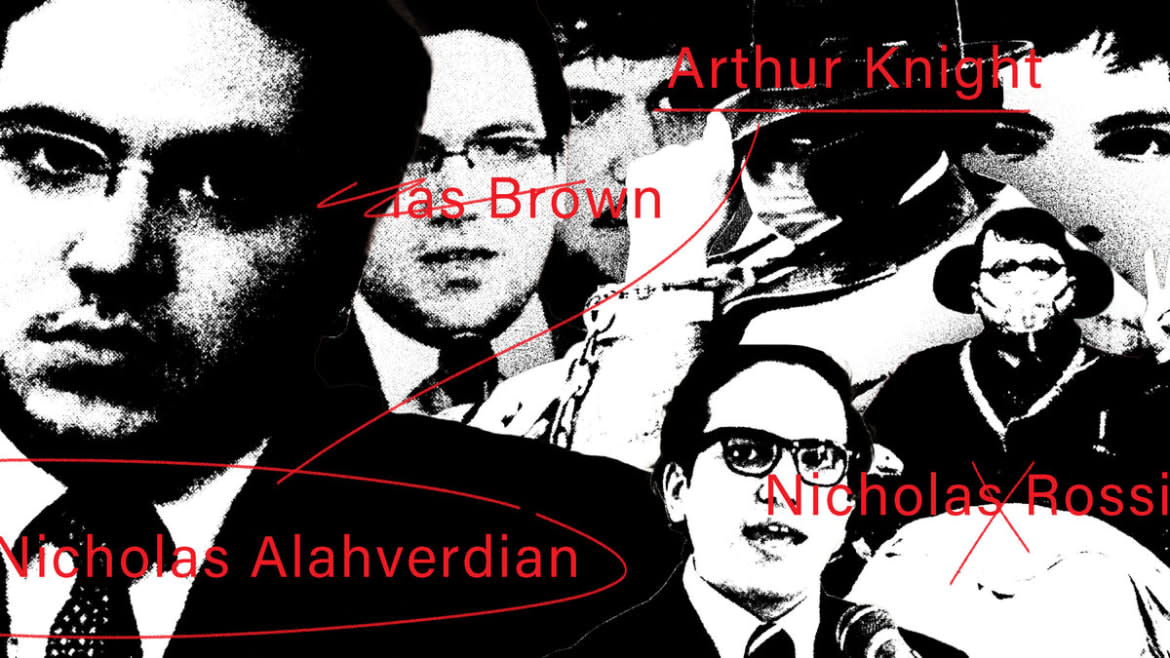
Last week, a dark-haired man wearing a pinstripe suit, shiny leather shoes, and round black glasses was wheeled into a court room in Edinburgh, Scotland—one hand shackled to a police officer.
He said he was Arthur Knight, an Irishman who had never been to the United States. Authorities told the Scottish court he was actually 35-year-old Nicholas Alahverdian—an accused conman from Rhode Island wanted on rape charges in Utah.
The judge ruled that there is no Arthur Knight—only Alahverdian living under a false name. Authorities say Knight is just the latest of Alahverdian’s 16 known aliases, which include Nicholas Rossi, Nicholas Brown, Arthur Brown, and Arthur Knight-Brown. He was identified through fingerprints and DNA, as well as an analysis of his distinctive tattoos.
“I am ultimately satisfied on the balance of probabilities that Mr Knight is indeed Nicholas Rossi, the person sought for extradition by the United States,” Judge Norman McFadyen determined after a three-day hearing.
In March, he will face extradition to the United States to face rape charges brought by David Leavitt, the Utah County Attorney.
Authorities in the U.S. say Alahverdian faked his own death in February 2020, wrote his own obituary and fled to Europe to avoid ongoing criminal investigations. They believe he reinvented himself as he had done many times before, dodging law enforcement across two continents.
Alahverdian’s story is the stuff of a multi-part drama. But this time around authorities are determined he will not escape justice.
The saga begins decades ago, and thousands of miles from the Scottish courtroom where he appeared last week. Alahverdian has left a long trail of alleged victims behind him. Many of them are women he allegedly conned, stole money from, and physically and sexually assaulted. And after years of seeking justice and warning authorities about his past crimes, his victims want the nightmare to end.
The Daily Beast can reveal that Alahverdian’s sexual violence goes back further than has previously been reported. By the age of 18, he was already a rapist, according to a woman sharing her story for the first time.
“Samantha”—who is using a pseudonym to protect her identity—says she met Alahverdian online when she was a sophomore in college in Massachusetts, a few weeks shy of her 19th birthday. The two were both originally from Providence, Rhode Island and were the same age. It was 2006 and Alahverdian was using the name Nicholas Rossi.
“Everything just seemed so perfect. He was super gentlemanly and very well-spoken and super kind and everything like that. He was fun to talk to,” Samantha told The Daily Beast. “I know now that everything that he did was incredibly scripted and out of a playbook.”
Once, Alahverdian “accidentally” forwarded her an email that happened to be a copy of his apparent acceptance letter to Harvard University. Now she thinks the letter was a fake, designed to impress her.
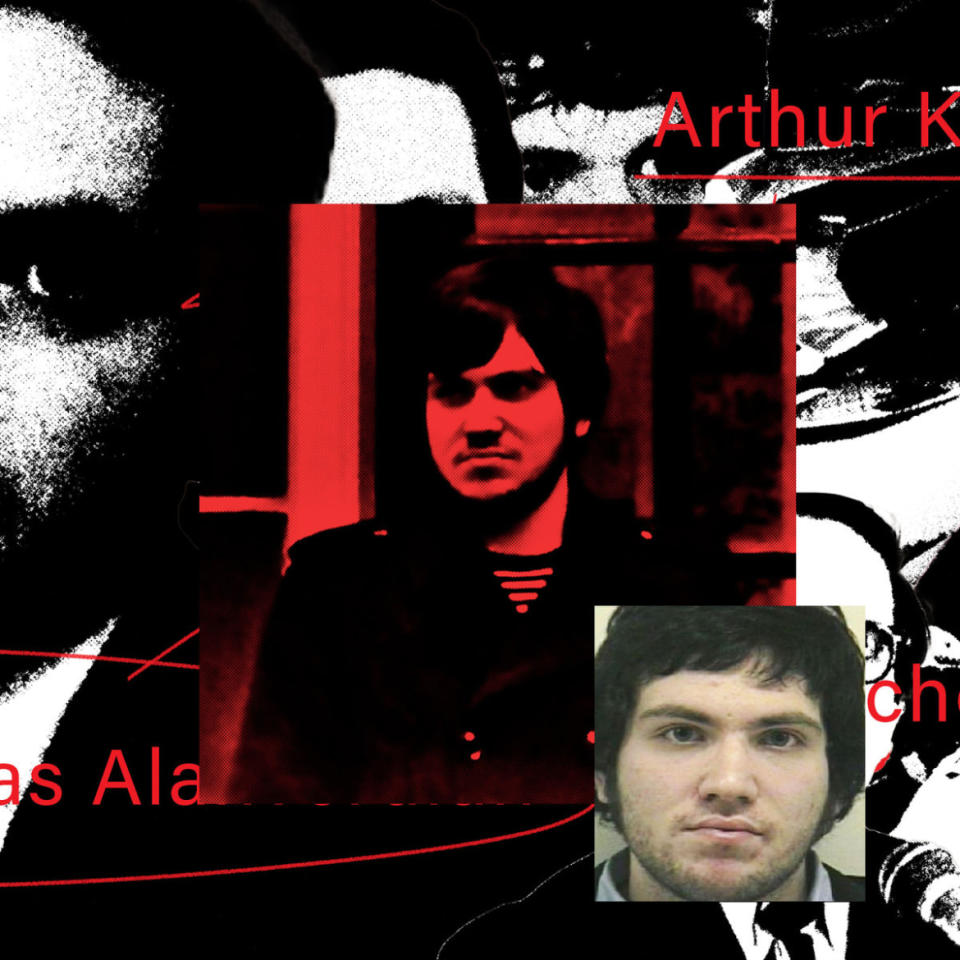
In 2008 Nicholas Alahverdian was found guilty of public indecency and sexual imposition.
The two arranged to meet in person. Alahverdian took a train and Samantha met him at the station. Alahverdian greeted her with the most forceful kiss she’s ever experienced. “I don’t know this person at all really and he just came on very, very strong.”
They went out for dinner at a restaurant before heading back to Samantha’s dorm to watch the movie Garden State. There, things took a turn for the worse.
“He kept pressuring me for sex, saying things like: ‘Oh, I just spent so long on the train.’ Just like, guilting me basically. And I was just trying to play it off,” Samantha says.
“I said no. I refused. I was like, I don’t want to do this. And he wouldn’t stop. He wouldn’t let it go. It got to the point where I was sick of hearing it from him,” she remembers. “And then I very specifically remember he threatened me. He said something like, ‘You’re going to regret it if you don’t.’ I was like: I don’t know what that means. I don’t know what that means, but I don’t want to find out what it means.”
Alahverdian climbed on top of her, Samantha says, and raped her.
She felt her brain go to a “different place,” unable to process the trauma and fear. The rest of the night was a blur. The next morning, she hurried Alahverdian out of the dorm, desperate to get rid of him. She had agreed to drop him off in Providence on her way home to visit family.
They stopped at a Dunkin’ Donuts drive-thru.
“I remember thinking: how fucked up is it that I’m buying my rapist breakfast right now?” Samantha says.
In the days after the rape, Samantha felt like a zombie, living in a haze. When she got back to her dorm, she threw out everything that Alahverdian had touched—the pillows, the bedding, the cup he drank from, even the movie they’d been watching.
Samantha didn’t report the attack to police. She says the culture around sexual assault in 2006 was different from our current post-Me Too era. There was an attitude of: “You invited him into your room, so you must have asked for it,” Samantha says.
Still, Samantha says she wrote Alahverdian a message on Facebook saying: “You raped me. It’s not ok,” and then blocked him.
A few weeks later, Samantha was in Providence on a weekend and she ran into Alahverdian in a public place.
“He looked at me. We locked eyes. And he said, ‘You’re not even going to say hi to me?’,” she recalls. She ran in the opposite direction. “I found a bathroom and puked my brains out, because it was that upsetting to me.”
Samantha’s friends worried for her well-being, and when she confided what had happened they took her to the school counselor.
That was the beginning of five years of therapy for Samantha, who says it has been hard to recover. “It’s not just the fact that this happened, but it bleeds into everything else,” she says. “How do I have a relationship with another human? How do I trust another human?”
Nicholas Alahverdian was born on July 11, 1987, in Rhode Island, the eldest of three children. His father, who had convictions for domestic assault and selling cocaine, left the family three years later, according to reporting by The Providence Journal.
In 1994, Nick’s mother Diana married David Rossi, an Engelbert Humperdinck impersonator, and they both took his last name, the first of his many new identities. His one-time stepfather told the newspaper that even as a young child, Nick was violent.
“He just wouldn’t listen in school, he hit the mother, hit the grandmother all the time, hit his siblings. I used to have to hold him down, and he’d be spitting at me,” Rossi said.
Eventually Nick became too difficult for his parents, and was put in the custody of the Rhode Island Department of Children, Youth and Families, according to the newspaper. By the time Nick was 12, he was living in a boys’ home in Woonsocket, Rhode Island.
Over the next couple of years, Nick pursued an ambition to enter the world of state politics. By the time he was 14, he was a “page” at the State House and Senate in Providence, running small errands for lawmakers and listening in during sessions. He ingratiated himself with local politicians, who remember him as courteous and helpful.
Joanne Giannini, a former Rhode Island state representative, described Nick as a well-dressed 15-year-old in a recently published essay for the Rhode Island Wave called “The Boy I Knew.” Nick seemed “like a clean-cut boy who loved politics and the State House,” she wrote.
As Giannini got to know Nick he opened up to her, telling her he had been abused while in state custody. Inspired by Nick’s story, Giannini worked with other lawmakers to author legislation to reform the child welfare system.
One former Rhode Island House Representative, Brian Coogan, told an NBC podcast that he even once considered adopting Nick.
Coogan said Nick once called him as a teenager and begged him to come down to family court to intercede with a judge on his behalf. Nick said he was going to be sent out of state because he had dared to speak up about the abuse he’d suffered in the foster system.

In 2009 Alahverdian reinvented himself as an advocate for children in the foster care system, attending galas and lobbying politicians, such as Vice President Mike Pence (left) and the then mayor of Providence, Vincent A. “Buddy” Cianci, Jr.
When Coogan arrived, he met privately with Jeremiah S. Jeremiah, Jr. who was then Chief Judge of Rhode Island’s Family Court. Judge Jeremiah told Coogan that Nick wasn’t telling him the whole story.
“Everything this young man is telling you, he is actually doing to other kids,” Coogan recalled Jeremiah saying, “If you adopt this kid, it will be nothing but a case of horrors. He’ll be accusing you or your family members. He’s not a normal kid.”
When he turned 18, Alahverdian was released from the custody of the state. An older couple in Ohio took him in a year later, acting as de facto foster parents and supporting him over the next few years. (Alahverdian was later accused of taking out 22 credit cards in his foster father’s name and running up debts of $200,000, according to The Providence Journal.)
It was in Ohio that Alahverdian committed the crime that would, years later, seal his fate.
Mary Grebinski was in her first term studying information technology at a small community college in Dayton, Ohio, when Alahverdian—still using the last name Rossi—reached out to her on MySpace in January 2008.
They attended the same school and Alahverdian said he’d like to get to know her. Grebinski was 18, living with her parents, and exploring her independence for the first time. She had no reason to be suspicious of a fellow student. He seemed charming. Grebinski said she had a boyfriend, but was open to being friends.
“He seemed to take the rejection pretty well,” she told The Daily Beast. “He was trying to gain my trust very quickly.”
The two continued chatting, and agreed to meet up at the school cafeteria. Grebinski brought a friend with her, and so did Alahverdian.
Alahverdian arrived wearing a sweater vest with a button-down underneath, slacks and dark glasses.
“We had a nice conversation. He was kind. He had big dreams. He was telling me how he wanted to be a lawyer, he wanted to write books,” she said. “I didn’t feel like he was pressuring me into anything romantic.”
Alahverdian asked if he could walk Grebinski to her class in the basement. As they entered an empty stairwell, he pinned her against a wall.
“He turned into a different person. He was forcibly kissing me, hands up my shirt, hands down my pants, hands inside of me,” Grebinski said, adding that she was “pushing him off me.”
But Alahverdian wouldn’t stop, Grebinski recalled, despite her pleas and resistance.
“I honestly thought he’s either going rape me, or rape me and kill me,” she says. “I met him like an hour ago, and it went from zero to a hundred real quick.”
Nick masturbated and ejaculated on the wall behind her. Grebinski managed to get free and run to her next class, where she started processing what had happened.
Grebinski went to the police immediately after school and reported the assault. Alahverdian admitted to police that there had been sexual contact, but claimed Grebinski was the “aggressor,” according to court documents viewed by The Daily Beast.
Grebinski took the stand in an Ohio court and told her story. At that point, it was her word against his.
“The victim-blaming at the trial was really hard,” she says, especially when she was questioned by Alahverdian’s defense counsel, “because she was pretty much saying that I deserved it, too.”
The court ultimately sided with Grebinski. Alahverdian was found guilty of public indecency and sexual imposition in March 2008. He was required to register as a sex offender.
“I was kind of upset he didn’t have jail time, but at the same time, I was relieved,” Grebinski says.
Alahverdian’s DNA and fingerprints were taken and added to a national database of sex offenders. It was these key pieces of forensic evidence that would later link him to a Utah rape case, leading to an international manhunt.
Grebinski thought it was over. She hoped she would never hear his name again.
That year, Samantha, whom Alahverdian had allegedly raped two years earlier, typed his name into a search engine and came across the court documents from Grebinski’s case.
“My heart sank,” she says. Samantha began to ask herself if she had made a mistake by not reporting Alahverdian. “If I had done it differently, could I have prevented this?”
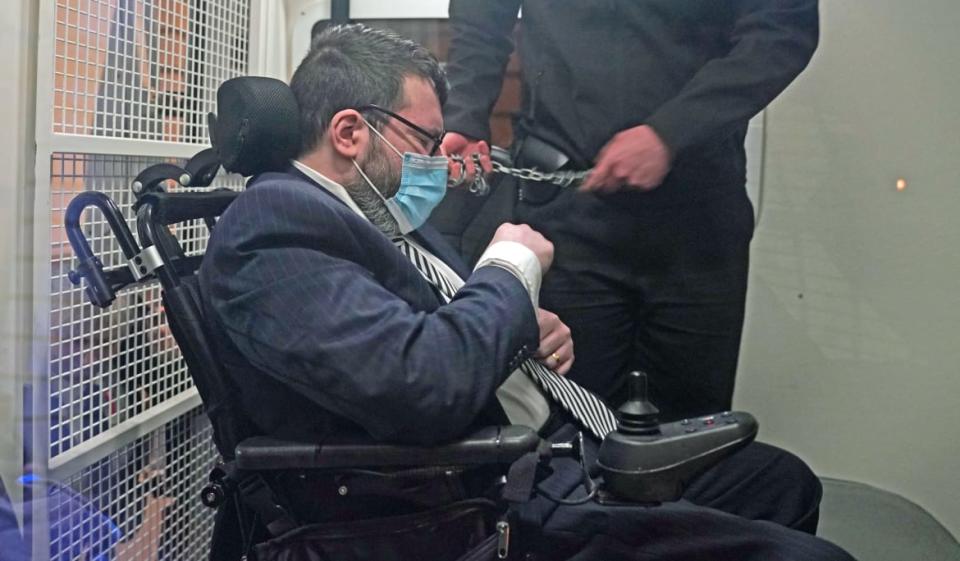
Nicholas Alahverdian goes by at least 16 other aliases.
Alahverdian, meanwhile, seemed undeterred by his new sex offender status.
In November 2008, he was in Utah, trawling the internet to meet women, according to documents released by the Salt Lake County District Attorney. Alahverdian met a 26-year-old woman online—who is identified only as “M.S” in the documents—and they dated for two months.
“M.S” told investigators that Alahverdian was “nice” and seemed “smart, university educated, interesting.” But he was also “manipulative,” had no job, and convinced her to lend him money that he did not pay back. He said he wanted to marry her. That December, M.S. says Alahverdian locked her in the bedroom, forced himself on top of her, and raped her.
Utah authorities now say Alahverdian also raped his 21-year-old former girlfriend in Orem, Utah, in the same year. Alahverdian allegedly lured the woman, who has not been named by authorities, back to his apartment, promising to repay money he owed her. After the alleged rape, she says he told her she was “mentally unstable and too emotional to deal with,” according to The Providence Journal.
In 2009, Alahverdian returned to Rhode Island, where over the next two years he reinvented himself as an advocate for children in the foster care system, lobbying politicians and attending fundraisers and galas.
“He was everywhere—the Governor’s office, the Senate, the House. Anywhere there was politicians, Nick was at,” former representative Coogan told an NBC podcast.
In 2011, Alahverdian (who had by then dropped the last name “Rossi'' in favor of his birth name) sued the Department of Children, Youth and Families of Rhode Island. He claimed he was raped and abused while in state custody as a minor. The state denied there was any evidence that Alahverdian had been abused, but settled the case for $70,000.
While he championed vulnerable children in his public life, Alahverdian continued to abuse women in private. Between 2010 and 2011, four different women filed complaints against him, according to The Providence Journal.
In one instance, a woman alleged that Alahverdian threw her to the floor and beat her after he became incensed that her baby son wouldn’t stop crying, according to an arrest report viewed by The Daily Beast. The woman was Alahverdian’s first wife, whom he had married only one week previously, according to The Providence Journal.
The woman’s roommate told police he had heard her screaming for help. Alahverdian was arrested, but refused to cooperate. The police officers carried him down the stairs to their car and pepper-sprayed him in the face. Alahverdian pleaded no contest to simple domestic assault, and the marriage soon ended, the newspaper reported.
Undeterred by his legal issues, Alahverdian continued to pursue his academic ambitions.
By 2012, Alahverdian was living in Cambridge, Massachusetts, attending comparative literature classes at Harvard extension. It was not the renowned university itself, but an adult education college where anyone can take classes.
But his life was about to unravel.
Alahverdian refused to accept his conviction for sexual imposition against Mary Grebinski in Ohio in 2008. He spent the next four years appealing his conviction multiple times. While studying in Boston, he was consumed by fighting the charges.
In 2012, Alahverdian tried to get a new trial based on what he described as “newly discovered evidence,” according to court documents. That evidence was a printed picture of a MySpace post apparently authored by Grebinski in which she seemed to recant her court testimony. A forensic computer expert dismissed the documents as fakes, according to court records. The court ruled the MySpace post was “not credible.”
Harvard Police arrested Alahverdian for missing a court date in Ohio and he was “administratively withdrawn” from his studies, putting an end to his fantasies of an Ivy League education.
Alahverdian’s resentment and anger against Mary Grebinski grew. He was active in online “men’s rights” forums and blogs, where his story was amplified as an example of legal bias and injustice against men.
In 2013, he sued Grebinski for defamation in a civil case, accusing her of subjecting him to “five years of unjust legal terror,” according to court documents. Grebinski says she felt completely unsupported by the prosecutors who had charged him in the criminal case.
“I was the victim of a crime. He is suing me. He is proven to have done this,” she says. “Nobody gave a shit about me. I really felt let down.”
She had to scramble to find thousands of dollars to hire a lawyer. “I had to borrow money from my parents and defend myself against this fucking creep.”
Alahverdian’s case against Grebinski was ultimately dismissed in 2014. Later that year he penned an essay titled “My Personal 9/11” where he wrote of Grebinski: “Her acts are tantamount to flying planes into my twin pillars of personal success and public service. My goals and aspirations crumbled to the earth, amassing a huge heap of rubble,” according to The Times of London.
Sex Offender Who Faked His Own Death Turns Up in Scotland—Nearly Dead From COVID
Alahverdian’s exact movements after he lost his civil case against Mary Grebinski are somewhat unclear. But by 2015, he was once again living with his former foster parents, this time in Utah, according to reporting by The Providence Journal.
That year, Alahverdian met Kathryn Heckendorn at a Mormon singles event, according to the newspaper. A few months later they were married, and Heckendorn moved with Alahverdian to Ohio. Immediately, she says, he became violent.
“The day after we got married, he hit me,” she told the newspaper, “Then it got worse and worse with the control—putting boundaries on what I could do, how I was supposed to dress.”
In their basement, Heckendorn found Alahverdian’s handwritten journals, which listed details of women he had been watching. The diaries included details of the women’s college schedules and their likes and dislikes, she told the newspaper.
Alahverdian verbally and physically abused her throughout the five months of their marriage, Heckendron said. He also borrowed $52,000 from her. In May 2016, the couple divorced, and the judge ordered Alahverdian to repay the money, according to divorce records. He never did, Heckendorn told The Providence Journal.
The following year, Alahverdian used OkCupid to connect with Michelle Minnear, a food blogger living in Essex, United Kingdom. In June 2017, he flew to the UK to meet her, Minnear told The Sunday Mail. He ended up moving into her home for five weeks.
“From the moment he walked in, he psychologically and emotionally wore me down,” Minnear told the newspaper. “Within days he was talking about getting married and doing calculations about how long it would take him to get his residency.”
Alahverdian raped her, she says, and spent £3,600 of her savings. In July 2017, Minnear changed her locks following advice from the police, she told the newspaper, and Alahverdian threatened to sue her, leaving her living in fear.
Unbeknownst to Alahverdian, the law was catching up to him.
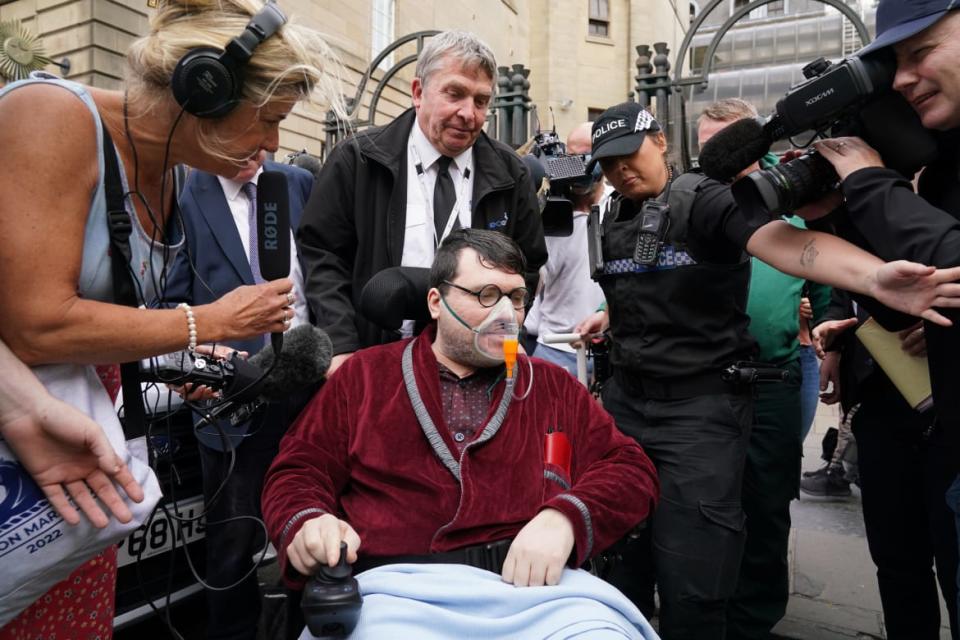
Nicholas Alahverdian leaves Edinburgh Sheriff and Justice Of The Peace Court.
The same year he targeted Minnear, the state of Utah received a grant to test back-logged rape kits, some of which had sat in storage for over a decade. One of these was taken after a 2008 rape in Orem, Utah. The test matched a name in the database: Nicholas Rossi (a.k.a. Alahverdian). Utah prosecutors began building a case against him.
By then Alahverdian was back in Rhode Island. He failed to register as a sex offender (a requirement of his conviction in Ohio) and had been placed on the state’s most wanted list. Police were actively looking for him.
By 2019, the FBI joined the hunt, looking to speak to Alahverdian about wire fraud charges, and the U.S. Marshals were also contacting lawmakers who had once known him, asking about his location.
It was then that Alahverdian suddenly announced he was dying.
Former representative Brian Coogan, who had known Alahverdian since he was a teenager, remembers Alahverdian telling him in a phone call that he had lymphoma. Coogan didn’t believe it, he told NBC.
“I know you. You’re not dying,” Coogan told Alahverdian, “You’re acting like you’re dying because the authorities are looking for you.”
But on Feb. 29, 2020, an obituary appeared online. Nicholas Alahverdian was dead, aged 32.
“His last words were ‘fear not and run toward the bliss of the sun’,” the obituary read. “At the time of his passing, the room was filled with the sounds of the end credits for the 1997 film Contact by composer Alan Silvestri, a film and score which held special meaning for Mr. Alahverdian.”
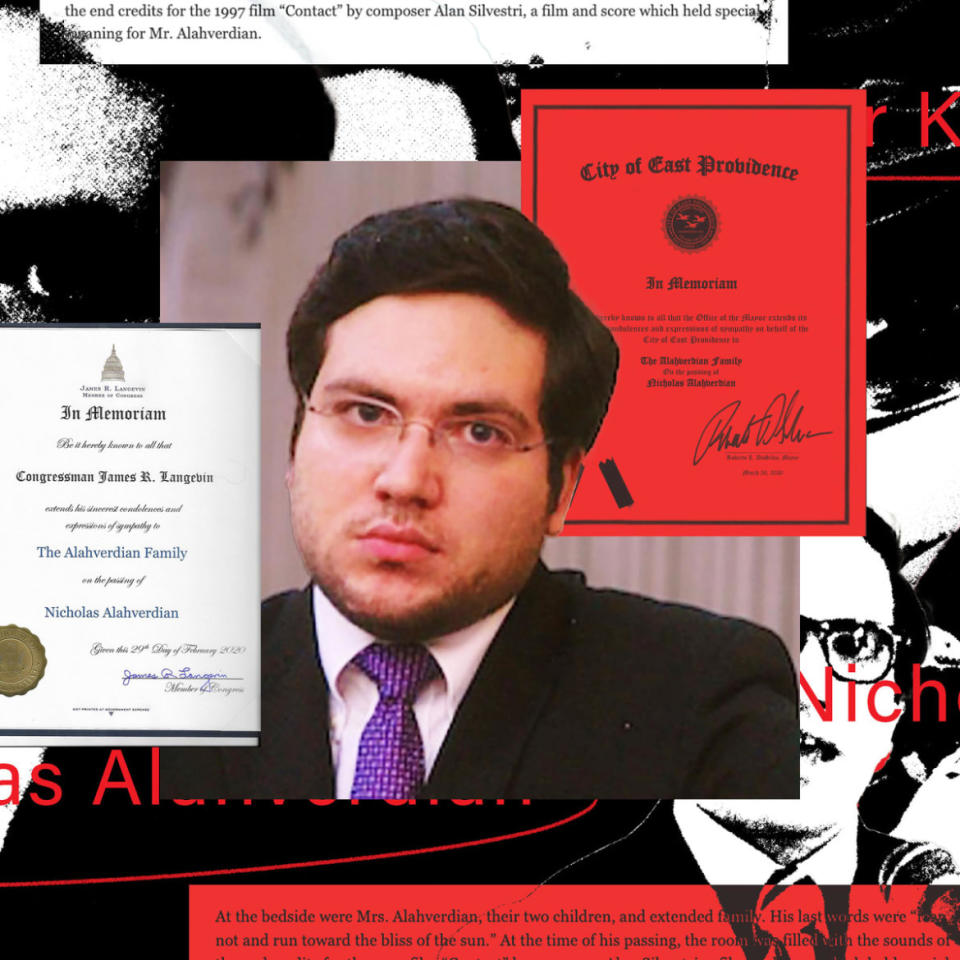
In February 2020 an obituary for Nicholas Alahverdian, age 32, surfaced online. Various Rhode Island lawmakers extended condolences for his death.
Soon afterwards, Samantha Googled Alahverdian’s name and came across the obituary. She felt a sense of closure. Maybe now, she could get on with her life.
But Coogan had his suspicions.
“I was 1000 percent sure he wrote his own obituary. I knew it was phony, I knew it was fake,” he told an NBC podcast.
Law enforcement in Rhode Island were coming to the same conclusion.
“Anyone who reads that obituary and has any kind of knowledge of Nicholas Alahverdian knew that he wrote that. One hundred percent,” Lieutenant Colonel Robert A. Creamer, of the Rhode Island State Police, told NBC. “There were certain things in that obituary that didn’t make sense for a person who had passed away.”
For example, police could find no evidence of a death certificate for Alahverdian. And the obituary mentioned a widow called “Louise” and two children. They also could not be located.
Now it seems that by the time of Alahverdian’s “death,” he was already long gone, having fled the U.S. and having landed in the U.K.
One month before Nick Alahverdian “died,” a man called Nicholas Brown was looking for work online.
In January 2020, Canadian chef and TV presenter Nafsika Antypas was looking for someone to help her with marketing for her A&E show Plant-Based with Nafsika. She connected with Nicholas Brown, a freelancer on UpWork. Brown was Alahverdian’s newest identity.
When they got on the phone, “Nick” seemed smart and interested. He said he was Harvard-educated and had worked on a TV project with Gordon Ramsay. She thought his voice sounded strange, with a pronounced stutter. He said he was Irish, but he spoke in an English accent. His ratings were good, so Antypas hired him.
It was the beginning of a financial and personal nightmare.
Fours month in, Antypas still hadn’t seen any evidence of Alahverdian’s work. She decided it was time to end the business relationship. She had already paid him $40,000 for work he had never delivered.
“That’s when he came back with a list of what he would do to me if I didn’t pay what he believed I owed him,” Antypas said.
“You have no clue who you’re dealing with,” Alahverdian wrote in a message to Antypas, shared with The Daily Beast. “Settle or your company and brand will be destroyed. End of story.”
Alahverdian demanded an entire year’s salary. He set up a website called “Nafsika Antypas Is A Fraud” and sent her screenshots of it.

A month before he “died” Alahverdian got a job working for Canadian chef and TV presenter Nafsika Antypas. After she tried to break ties with him for not producing work, he sent threatening texts and set up a website calling her a fraud.
When she refused to pay, Alahverdian bombarded her parents’ house with phone calls and threatened to sue her and her father’s company, Antypas said.
Antypas tried to report Alahverdian to police in the U.K., but was told they couldn’t help her. When she called the crime hotline in Montreal, Canadian police told her to speak to U.K. authorities. Alahverdian had told her he was Irish, so she also tried calling the police in Dublin, who told her to call Canada. She felt like law enforcement were giving her the run around.
In desperation, she hired a private detective in Dublin to search for Nicholas Brown. He told her no such person existed: “You’re dealing with a con man.”
The ordeal cost Antypas far more than just the $40,000 she paid to Alahverdian. She had to hire lawyers to write a letter to Alahverdian, a company to help clean up lies he spread about her on the internet, and a fee for the private detective.
“I’m scared to tally up everything I’ve spent so far,” she says. “It was months and months of hell.”
Antypas feels that if law enforcement had taken her more seriously when she tried to report Alahverdian in mid-2020, perhaps he could have been stopped earlier.
“It drove me crazy that no one took my case seriously,” she says. “In two years he did a lot of damage. I could have shut him down if they had helped me.”
Four months after Antypas fired Alahverdian, the Salt Lake County Attorney announced it was seeking to arrest him on the 2008 rape charge. Alahverdian had “faked his own death and fled to Scotland,” the warrant read. The noose was tightening.
In Dec. 13, 2021, a man who had checked himself in as “Arthur Knight” lay on a ventilator in a Glasgow hospital, seriously ill with COVID-19. His wife of two years, Miranda, sat with him.
Scottish police had been working with hospital staff to identify the sick man based on his numerous tattoos—including a coat of arms with open books in each quarter surrounding a red St George’s cross and a single angel’s wing.
“Arthur Knight,” they said, did not exist. Knight’s real name was Nicholas Rossi a.k.a. Alahverdian, and they arrested him that winter day under an international warrant, on behalf of investigators in Utah.
“Our victim in Utah has been suffering now for all these 13 years,” David Leavitt, the Utah County Attorney, told BBC Scotland following the arrest, "Our office is grateful for the significant inter-agency collaboration of law enforcement to bring this suspect to justice."
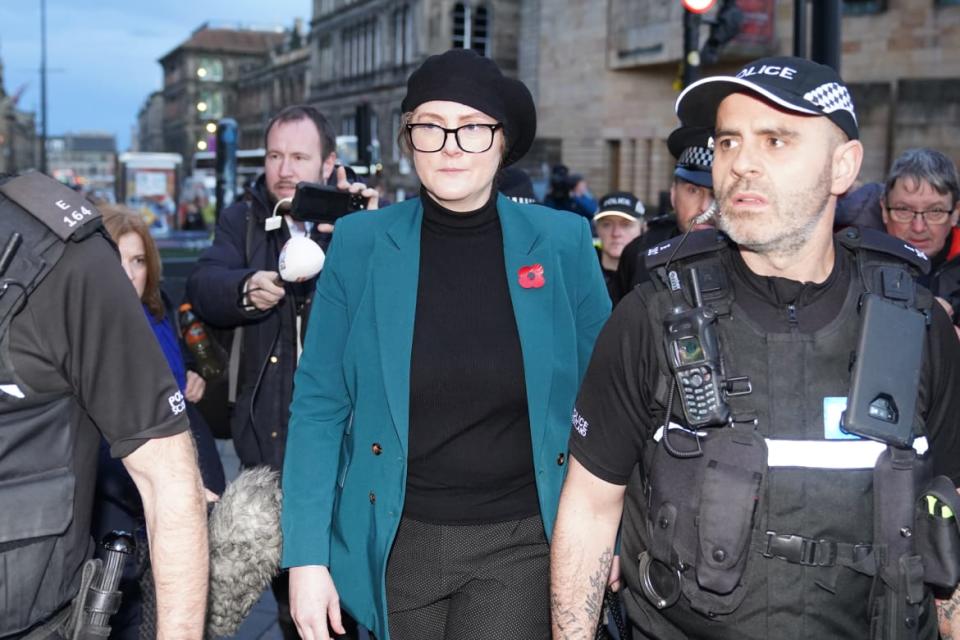
Miranda Knight, the wife of the defendant, departing Edinburgh Sheriff And Justice Of The Peace Court, following a hearing on the extradition of Nicholas Alahverdian to the US.
Knight immediately denied the charges, insisting to all who would listen that he was the victim of mistaken identity. He claimed he was an Irish orphan, who had never set foot in the United States.
Accompanied by Miranda Knight, whom he married in February 2020, he gave numerous interviews to the press, often wearing a three-piece suit with a pocket square, and using an oxygen mask that obscured his uneven English accent. He vehemently denied allegations of rape.
“This is a vicious lie,” he told a TV reporter from Scotland’s STV News.
Many reporters asked about his tattoos. Knight refused to roll his sleeves up above the elbow.
In August 2022, a reporter from Sky News Scotland who was interviewing him and Miranda Knight in their Glasgow apartment even FaceTimed former Rhode Island lawmaker Brian Coogan, holding the phone up so that he could see the man in question.
“Hi, Nick, how are you doing?” Coogan said. But Knight refused to speak to him.
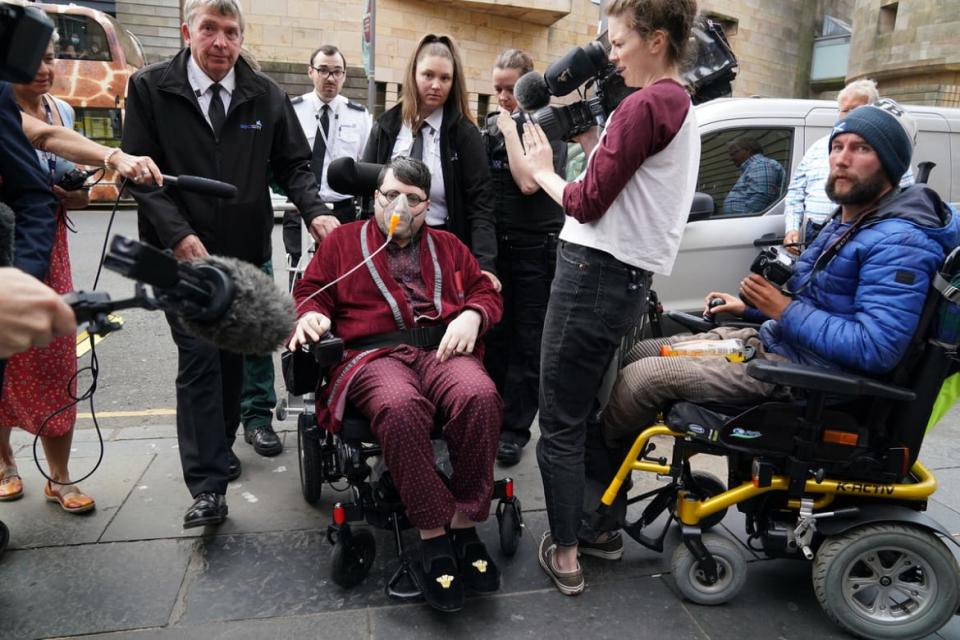
Nicholas Alahverdian is wheeled into a Scottish court.
David Rossi, Alahverdian’s former stepfather, was also shown footage by STV News of the man calling himself Arthur Knight.
“That’s my son. There he is, right there,” he said. “That’s my Nicky.”
Knight’s court appearances and public persona became increasingly unhinged. He hired and fired defense lawyers. He publicly accused David Leavitt—the Utah County Attorney behind the extradition effort—of engaging in Satanic child abuse. He refused to provide DNA samples to Scottish authorities.
But the farce could not go on forever. In July 2022, Knight was once again back in hospital where he verbally abused staff, at one point leaping out of bed to run at a nurse and consultant who were caring for him, both of whom fled from the room. He was arrested and his fingerprints were taken.
Those fingerprints matched those of Nicholas Alahverdian taken all those years ago, prosecutor Julie Clark told the Scottish court. He was denied bail.
Last week, as the court met to finally decide on his true identity, “Arthur Knight” argued that his extensive tattoos (which match those of Alahverdian) had appeared on his body while he lay in a coma in hospital in an effort by a health-care worker called “Patrick” to frame him.
The judge, Norman McFadyen, was unconvinced. He concluded that Arthur Knight was indeed Nicholas Alahverdian.
McFadyen said Alahverdian’s claims of mistaken identity were “implausible” and “fanciful” and that his repeatedly changing his name was “highly suspicious.”
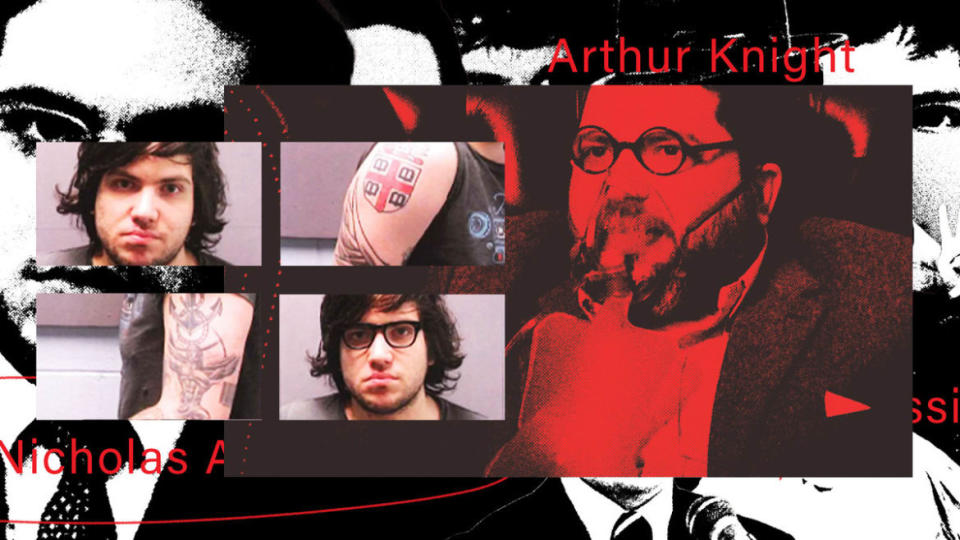
A Scottish judge ruled that a man calling himself Arthur Knight is in fact Nicholas Alahverdian, due largely to his distinctive tattoos.
An extradition hearing will take place in March next year.
It was only last weekend that Samantha discovered Alahverdian was not dead. While visiting Rhode Island she saw a local newspaper report about the Scottish ruling on Alahverdian’s identity. She hadn’t heard anything about him since his obituary in 2020.
“I was like, you’ve got to be kidding me!” she says. “I am going to watch a Netflix documentary about this, and I will have lived it.”
Now she is processing the fact that Alahverdian may finally face justice.
“I do believe I’m the tip of the iceberg. I believe I was one of many, many girls he did this to. So, does he even remember me? I don’t know. Well, how many did you rape?” she says. “I don’t know if you remember me, but I’ve remembered you for the last 17 years. You don’t forget that.”
In Canada, Nafsika Antypas felt an enormous sense of relief.
Before the ruling, she was anxious that he might wriggle out of the grip of the justice system, as he had many times before, and disappear to a new life with another identity.
“I know he’s a schemer and he was scheming the court and always coming up with these excuses and lies,” she told The Daily Beast. “But it’s too late.”
Alahverdian has played his final card, she thinks, and lost.
For Mary Grebinski, who has spent much of her adult life dealing with Alahverdian’s attacks through the courts, that trial cannot come soon enough. She plans to travel to Utah to watch the court proceedings in person.
Grebinski is frustrated that the case is moving slowly. But she has come to realize how her actions as a frightened 18-year-old have become part of a much bigger story—one she could not have imagined at the time.
If she had not reported Alahverdian sexual assault in an Ohio stairwell, his fingerprints and DNA would not have been on file, there would have been no match in the Utah rape case, and he never would have been arrested in Scotland.
“Everybody says actions ripple out, right? And me reporting the case, getting him on the registry, getting him fingerprinted, rippled out into something so much bigger,” she said.
The final chapter in this stranger-than-fiction story is yet to be written but Samantha, Mary Grebinski, and Nafsika Antypas, along with all the others Alahverdian hurt and scammed, are watching to see what kind of verdict will be handed down.
Grebinski hopes he will get the maximum penalty available under Utah law for rape—life imprisonment. Samantha and Antypas, too, are hoping for a hefty sentence.
“I’m so happy that he is going to answer to the charges and face the reality. I do believe that he is wired wrong in his brain. And I don’t know how self-aware he is. But I do 100 percent believe that this person is wired wrong,” Samantha says. “And he needs to answer for what he’s done.”
Get the Daily Beast's biggest scoops and scandals delivered right to your inbox. Sign up now.
Stay informed and gain unlimited access to the Daily Beast's unmatched reporting. Subscribe now.

